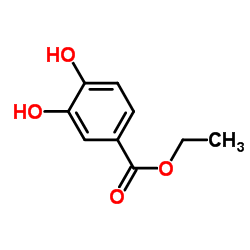Ethyl 3,4-dihydroxybenzoate

Ethyl 3,4-dihydroxybenzoate structure
|
Common Name | Ethyl 3,4-dihydroxybenzoate | ||
|---|---|---|---|---|
| CAS Number | 3943-89-3 | Molecular Weight | 182.173 | |
| Density | 1.3±0.1 g/cm3 | Boiling Point | 358.1±22.0 °C at 760 mmHg | |
| Molecular Formula | C9H10O4 | Melting Point | 132-134 °C(lit.) | |
| MSDS | Chinese USA | Flash Point | 147.0±15.8 °C | |
| Symbol |

GHS07 |
Signal Word | Warning | |
|
Antioxidant activity of protocatechuates evaluated by DPPH, ORAC, and CAT methods.
Food Chem. 194 , 749-57, (2015) Hibiscus sabdariffa L. is a worldwide consumed plant, principally after infusion of its dried sepals and calyces, which are usually discarded. Nevertheless, they represent a potential source of natural bioactive compounds, e.g. polyphenols, which could add va... |
|
|
Inhibitory Effect of Dried Pomegranate Concentration Powder on Melanogenesis in B16F10 Melanoma Cells; Involvement of p38 and PKA Signaling Pathways.
Int. J. Mol. Sci. 16 , 24219-42, (2015) Plants rich in antioxidant substances may be useful for preventing skin aging. Pomegranates, containing flavonoids and other polyphenolic compounds, are widely consumed due to their beneficial properties. We examined the underlying mechanisms of dried pomegra... |
|
|
Evidence for a role of collagen synthesis in arterial smooth muscle cell migration.
J. Clin. Invest. 101(9) , 1889-98, (1998) Migration of smooth muscle cells (SMCs) and collagen synthesis by SMCs are central to the pathophysiology of vascular disease. Both processes can be induced shortly after vascular injury; however, a functional relationship between them has not been establishe... |
|
|
Improvement of pro-oxidant capacity of protocatechuic acid by esterification.
PLoS ONE 9(10) , e110277, (2014) Pro-oxidant effects of phenolic compounds are usually correlated to the one-electron redox potential of the phenoxyl radicals. Here we demonstrated that, besides their oxidizability, hydrophobicity can also be a decisive factor. We found that esterification o... |
|
|
Analytical method for the determination and a survey of parabens and their derivatives in pharmaceuticals.
Environ. Res. 142 , 452-60, (2015) Exposure of humans to parabens is a concern due to the estrogenic activity of these compounds. Parabens are widely used as preservatives in some personal care products, foodstuffs and pharmaceuticals owing to their low cost, high water solubility and broad sp... |
|
|
A High-Throughput UHPLC-QqQ-MS Method for Polyphenol Profiling in Rosé Wines.
Molecules 20 , 7890-914, (2015) A rapid, sensitive and selective analysis method using Ultra High Performance Liquid Chromatography coupled to triple-quadrupole Mass Spectrometry (UHPLC-QqQ-MS) has been developed for the quantification of polyphenols in rosé wines. The compound detection be... |
|
|
Amelioration of cognitive, motor and endogenous defense functions with silymarin, piracetam and protocatechuic acid in the cerebral global ischemic rat model.
Life Sci. 93(1) , 51-7, (2013) The neuroprotective activities of silymarin, piracetam and protocatechuic acid ethyl ester (PCA) on cerebral global ischemic/reperfusion were evaluated in a rat model.A midline ventral incision was made in the throat region. The right and left common carotid ... |
|
|
cis-4-Hydroxy-L-proline and ethyl-3,4-dihydroxybenzoate prevent myogenesis of C2C12 muscle cells and block MyoD1 and myogenin expression.
Exp. Cell Res. 200 , 70-6, (1992) cis-4-Hydroxy-L-proline (cis-OH-Pro) and ethyl-3,4-dihydroxybenzoate (EDHB), two distinct inhibitors of collagen synthesis, prevented myogenesis in C2C12 mouse skeletal muscle cells. Both inhibitors blocked myotube formation and the expression of sarcomeric m... |
|
|
Preconditioning protects against oxidative injury involving hypoxia-inducible factor-1 and vascular endothelial growth factor in cultured astrocytes.
Eur. J. Pharmacol. 633(1-3) , 24-32, (2010) Tolerance to brain injury involves hypoxia-inducible factor-1 (HIF-1) and its target genes as the key pathway mediating a cascade of events including cell survival, energetics, and angiogenesis. In this study, we established the treatment paradigms for an in ... |
|
|
The prolyl 4-hydroxylase inhibitor ethyl-3,4-dihydroxybenzoate generates effective iron deficiency in cultured cells.
FEBS Lett. 529(2-3) , 309-12, (2002) Ethyl-3,4-dihydroxybenzoate (EDHB) is commonly utilized as a substrate analog and competitive inhibitor of prolyl 4-hydroxylases. These iron-dependent enzymes have received a lot of attention for their involvement in crucial biochemical pathways such as colla... |